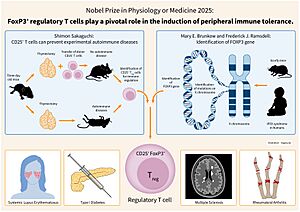Mary E. Brunkow facts for kids
Quick facts for kids
Mary Brunkow
|
|
|---|---|
| Born | 1961 (age 63–64) Portland, Oregon, United States
|
| Education | University of Washington (BS) Princeton University (PhD) |
| Known for | FOXP3 |
| Awards | Nobel Prize in Physiology or Medicine (2025) |
| Scientific career | |
| Fields | Immunology Molecular biology |
| Institutions | Institute for Systems Biology Celltech R&D |
| Thesis | Expression and function of the H19 gene in transgenic mice (1991) |
| Doctoral advisor | Shirley M. Tilghman |
Mary Elizabeth Brunkow (born in 1961) is an American scientist. She is an expert in molecular biology, which studies tiny parts of living things like DNA. She is also an immunologist, meaning she studies the body's amazing defense system.
Mary Brunkow is famous for helping to find a special gene called FOXP3. This gene helps control our body's defenses. Her discovery helped us understand how our immune system knows not to attack our own body. For this important work, she was awarded the Nobel Prize in Physiology or Medicine in 2025.
Contents
Who is Mary Brunkow?
Mary Brunkow is a brilliant scientist. She helped us understand how our body's defense system works. Her discoveries are very important for medicine.
Her Early Life and Education
Mary Brunkow was born in 1961 in Portland, Oregon, in the United States. She went to St. Mary's Academy and finished in 1979.
She studied at the University of Washington. In 1983, she earned a degree in molecular and cellular biology. Later, she went to Princeton University. There, she earned a PhD in molecular biology in 1991. A PhD is a very advanced degree. For her PhD, she wrote a long research paper. It was about how a gene called H19 works in mice. Her teacher was Shirley M. Tilghman.
Her Career as a Scientist
After her studies, Mary Brunkow worked in research. She worked at a company called Celltech R&D in Bothell, Washington. It was there that she and another scientist, Fred Ramsdell, made their Nobel Prize-winning discovery about the FOXP3 gene. Later, she worked as a senior program manager at the Institute for Systems Biology in Seattle.
Mary Brunkow's Important Discoveries
Mary Brunkow's research changed how we understand the immune system. She helped uncover a key part of how our body protects itself.
Understanding the Immune System
In 2001, Mary Brunkow was part of a team that published a paper. This paper was in a science magazine called Nature Genetics. They found a gene that caused a problem in mice. This problem was called the "scurfy mouse phenotype." It meant the mice's immune systems were attacking their own bodies.
They named the gene product "scurfin," which later became known as FOXP3. When this FOXP3 gene didn't work correctly, it caused serious immune problems. The body's defense cells, called T cells, would become overactive. This showed that FOXP3 is like a "stop sign" for the immune system. It helps prevent the body from attacking itself.
This discovery was very important. It helped scientists understand how our immune system learns to be "tolerant." This means it knows which cells are part of our body and which are invaders. This ability is called "peripheral immune tolerance." It happens outside the main training area for immune cells. Mary Brunkow's work opened the door for much more research. It helped us learn how to keep our immune system balanced and healthy.
Awards and Recognition
Mary Brunkow's groundbreaking work earned her one of the highest honors in science.
The Nobel Prize in Medicine
On October 6, 2025, a big announcement was made. The Nobel Assembly at the Karolinska Institute in Stockholm, Sweden, shared exciting news. Mary Brunkow, along with Fred Ramsdell and Shimon Sakaguchi, received the Nobel Prize in Physiology or Medicine. They were honored for their discoveries about how the immune system avoids attacking itself.
Mary Brunkow became the fourteenth woman to win the Nobel Prize in the medicine category. This is a huge achievement!
See also
 In Spanish: Mary Brunkow para niños
In Spanish: Mary Brunkow para niños


